
A Pacific harbor seal pup hauls out on a sandy beach. This group of harbor seals, which has formed a breeding colony at a small but popular beach near San Diego, is at the center of considerable controversy. While harbor seals are protected from harassment by the Marine Mammal Protection Act and other legislation, local interests would like to see the seals leave so that people can resume using the beach.
Species: Pacific harbor seal, Phoca vitulina richardsi
Location: La Jolla, California
Image ID: 02162
Species: Pacific harbor seal, Phoca vitulina richardsi
Location: La Jolla, California
Image ID: 02162
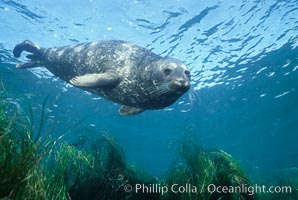
A Pacific harbor seal swims over surf grass in the protected waters of Childrens Pool in La Jolla, California. This group of harbor seals, which has formed a breeding colony at a small but popular beach near San Diego, is at the center of considerable controversy. While harbor seals are protected from harassment by the Marine Mammal Protection Act and other legislation, local interests would like to see the seals leave so that people can resume using the beach.
Species: Pacific harbor seal, Phoca vitulina richardsi
Location: La Jolla, California
Image ID: 03021
Species: Pacific harbor seal, Phoca vitulina richardsi
Location: La Jolla, California
Image ID: 03021

A Pacific harbor seal hauls out on a sandy beach. This group of harbor seals, which has formed a breeding colony at a small but popular beach near San Diego, is at the center of considerable controversy. While harbor seals are protected from harassment by the Marine Mammal Protection Act and other legislation, local interests would like to see the seals leave so that people can resume using the beach.
Species: Pacific harbor seal, Phoca vitulina richardsi
Location: La Jolla, California
Image ID: 10427
Species: Pacific harbor seal, Phoca vitulina richardsi
Location: La Jolla, California
Image ID: 10427

A young loggerhead turtle. This turtle was hatched and raised to an age of 60 days by a turtle rehabilitation and protection organization in Florida, then released into the wild near the Northern Bahamas.
Species: Loggerhead turtle, Caretta caretta
Location: Bahamas
Image ID: 10886
Species: Loggerhead turtle, Caretta caretta
Location: Bahamas
Image ID: 10886
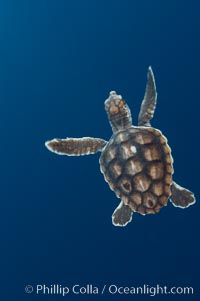
A young loggerhead turtle. This turtle was hatched and raised to an age of 60 days by a turtle rehabilitation and protection organization in Florida, then released into the wild near the Northern Bahamas.
Species: Loggerhead turtle, Caretta caretta
Location: Bahamas
Image ID: 10887
Species: Loggerhead turtle, Caretta caretta
Location: Bahamas
Image ID: 10887

Pacific harbor seal swims in the protected waters of Childrens Pool in La Jolla, California. This group of harbor seals, which has formed a breeding colony at a small but popular beach near San Diego, is at the center of considerable controversy. While harbor seals are protected from harassment by the Marine Mammal Protection Act and other legislation, local interests would like to see the seals leave so that people can resume using the beach.
Species: Pacific harbor seal, Phoca vitulina richardsi
Location: La Jolla, California
Image ID: 03017
Species: Pacific harbor seal, Phoca vitulina richardsi
Location: La Jolla, California
Image ID: 03017

This Pacific harbor seal has an ear with no external ear flaps, marking it as a true seal and not a sea lion. La Jolla, California. This group of harbor seals, which has formed a breeding colony at a small but popular beach near San Diego, is at the center of considerable controversy. While harbor seals are protected from harassment by the Marine Mammal Protection Act and other legislation, local interests would like to see the seals leave so that people can resume using the beach.
Species: Pacific harbor seal, Phoca vitulina richardsi
Location: La Jolla, California
Image ID: 01957
Species: Pacific harbor seal, Phoca vitulina richardsi
Location: La Jolla, California
Image ID: 01957
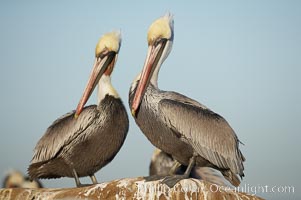
Brown pelicans preening. After wiping its long beak on the uropygial gland near the base of its tail, the pelican spreads the preen oil on feathers about its body, helping to keep them water resistant, an important protection for a bird that spends much of its life diving in the ocean for prey. Adult winter non-breeding plumage showing white hindneck.
Species: Brown Pelican, Pelecanus occidentalis, Pelecanus occidentalis californicus
Location: La Jolla, California
Image ID: 20089
Species: Brown Pelican, Pelecanus occidentalis, Pelecanus occidentalis californicus
Location: La Jolla, California
Image ID: 20089

Damselfish find protection within the branches of a hard coral, Fiji.
Location: Wakaya Island, Lomaiviti Archipelago, Fiji
Image ID: 31737
Location: Wakaya Island, Lomaiviti Archipelago, Fiji
Image ID: 31737

California Sea Lions in La Jolla Cove, these sea lions are seeking protection from large waves by staying in the protected La Jolla Cove.
Species: California sea lion, Zalophus californianus
Location: La Jolla, California
Image ID: 39801
Species: California sea lion, Zalophus californianus
Location: La Jolla, California
Image ID: 39801

California Sea Lions in La Jolla Cove, these sea lions are seeking protection from large waves by staying in the protected La Jolla Cove.
Species: California sea lion, Zalophus californianus
Location: La Jolla, California
Image ID: 39802
Species: California sea lion, Zalophus californianus
Location: La Jolla, California
Image ID: 39802

California Sea Lions in La Jolla Cove, these sea lions are seeking protection from large waves by staying in the protected La Jolla Cove.
Species: California sea lion, Zalophus californianus
Location: La Jolla, California
Image ID: 39803
Species: California sea lion, Zalophus californianus
Location: La Jolla, California
Image ID: 39803

Sandhill cranes landing in water ponds at dusk, spending the night standing in water as a protection against coyotes and other predators. Motion blur.
Species: Sandhill Crane, Grus canadensis
Location: Bosque del Apache National Wildlife Refuge, Socorro, New Mexico
Image ID: 39927
Species: Sandhill Crane, Grus canadensis
Location: Bosque del Apache National Wildlife Refuge, Socorro, New Mexico
Image ID: 39927

Brown pelican in flight. Adult winter non-breeding plumage. Brown pelicans were formerly an endangered species. In 1972, the United States Environmental Protection Agency banned the use of DDT in part to protect bird species like the brown pelican . Since that time, populations of pelicans have recovered and expanded. The recovery has been so successful that brown pelicans were taken off the endangered species list in 2009.
Species: Brown Pelican, Pelecanus occidentalis, Pelecanus occidentalis californicus
Location: La Jolla, California
Image ID: 40012
Species: Brown Pelican, Pelecanus occidentalis, Pelecanus occidentalis californicus
Location: La Jolla, California
Image ID: 40012

Brown pelican in flight. Adult winter breeding plumage. Brown pelicans were formerly an endangered species. In 1972, the United States Environmental Protection Agency banned the use of DDT in part to protect bird species like the brown pelican . Since that time, populations of pelicans have recovered and expanded. The recovery has been so successful that brown pelicans were taken off the endangered species list in 2009.
Species: Brown Pelican, Pelecanus occidentalis, Pelecanus occidentalis californicus
Location: La Jolla, California
Image ID: 40013
Species: Brown Pelican, Pelecanus occidentalis, Pelecanus occidentalis californicus
Location: La Jolla, California
Image ID: 40013

Brown pelican in flight. Adult winter breeding plumage. Brown pelicans were formerly an endangered species. In 1972, the United States Environmental Protection Agency banned the use of DDT in part to protect bird species like the brown pelican . Since that time, populations of pelicans have recovered and expanded. The recovery has been so successful that brown pelicans were taken off the endangered species list in 2009.
Species: Brown Pelican, Pelecanus occidentalis, Pelecanus occidentalis californicus
Location: Bolsa Chica State Ecological Reserve, Huntington Beach, California
Image ID: 40014
Species: Brown Pelican, Pelecanus occidentalis, Pelecanus occidentalis californicus
Location: Bolsa Chica State Ecological Reserve, Huntington Beach, California
Image ID: 40014
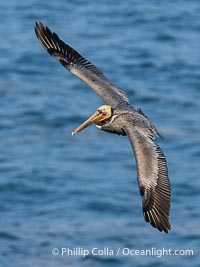
Brown pelican in flight. Adult winter breeding plumage. Brown pelicans were formerly an endangered species. In 1972, the United States Environmental Protection Agency banned the use of DDT in part to protect bird species like the brown pelican . Since that time, populations of pelicans have recovered and expanded. The recovery has been so successful that brown pelicans were taken off the endangered species list in 2009.
Species: Brown Pelican, Pelecanus occidentalis, Pelecanus occidentalis californicus
Location: La Jolla, California
Image ID: 40015
Species: Brown Pelican, Pelecanus occidentalis, Pelecanus occidentalis californicus
Location: La Jolla, California
Image ID: 40015
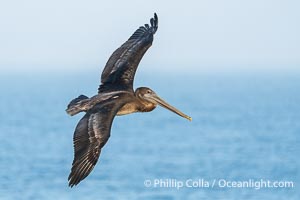
Juvenile Brown pelican in flight. Brown pelicans were formerly an endangered species. In 1972, the United States Environmental Protection Agency banned the use of DDT in part to protect bird species like the brown pelican . Since that time, populations of pelicans have recovered and expanded. The recovery has been so successful that brown pelicans were taken off the endangered species list in 2009.
Species: Brown Pelican, Pelecanus occidentalis, Pelecanus occidentalis californicus
Location: La Jolla, California
Image ID: 40016
Species: Brown Pelican, Pelecanus occidentalis, Pelecanus occidentalis californicus
Location: La Jolla, California
Image ID: 40016

Sandhill cranes landing in water ponds at dusk, spending the night standing in water as a protection against coyotes and other predators. Motion blur.
Species: Sandhill crane, Grus canadensis
Location: Bosque del Apache National Wildlife Refuge, Socorro, New Mexico
Image ID: 38775
Species: Sandhill crane, Grus canadensis
Location: Bosque del Apache National Wildlife Refuge, Socorro, New Mexico
Image ID: 38775
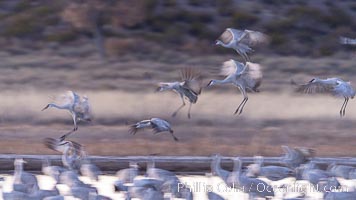
Sandhill cranes landing in water ponds at dusk, spending the night standing in water as a protection against coyotes and other predators. Motion blur.
Species: Sandhill crane, Grus canadensis
Location: Bosque del Apache National Wildlife Refuge, Socorro, New Mexico
Image ID: 38776
Species: Sandhill crane, Grus canadensis
Location: Bosque del Apache National Wildlife Refuge, Socorro, New Mexico
Image ID: 38776

Sandhill cranes will spend the night in ponds as protection from coyotes and other predators. The pond is often frozen in the morning.
Species: Sandhill crane, Grus canadensis
Location: Bosque del Apache National Wildlife Refuge, Socorro, New Mexico
Image ID: 38777
Species: Sandhill crane, Grus canadensis
Location: Bosque del Apache National Wildlife Refuge, Socorro, New Mexico
Image ID: 38777

Sandhill cranes will spend the night in ponds as protection from coyotes and other predators. The pond is often frozen in the morning.
Species: Sandhill crane, Grus canadensis
Location: Bosque del Apache National Wildlife Refuge, Socorro, New Mexico
Image ID: 38782
Species: Sandhill crane, Grus canadensis
Location: Bosque del Apache National Wildlife Refuge, Socorro, New Mexico
Image ID: 38782

Sandhill cranes landing in water ponds at dusk, spending the night standing in water as a protection against coyotes and other predators. Motion blur.
Species: Sandhill crane, Grus canadensis
Location: Bosque del Apache National Wildlife Refuge, Socorro, New Mexico
Image ID: 38794
Species: Sandhill crane, Grus canadensis
Location: Bosque del Apache National Wildlife Refuge, Socorro, New Mexico
Image ID: 38794
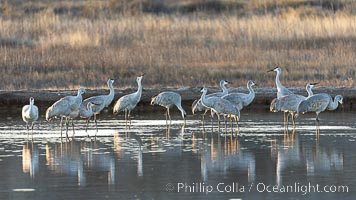
Sandhill cranes will spend the night in ponds as protection from coyotes and other predators. The pond is often frozen in the morning.
Species: Sandhill crane, Grus canadensis
Location: Bosque del Apache National Wildlife Refuge, Socorro, New Mexico
Image ID: 38796
Species: Sandhill crane, Grus canadensis
Location: Bosque del Apache National Wildlife Refuge, Socorro, New Mexico
Image ID: 38796

Brown pelican preening. After wiping its long beak on the uropygial gland near the base of its tail, the pelican spreads the preen oil on feathers about its body, helping to keep them water resistant, an important protection for a bird that spends much of its life diving in the ocean for prey. Adult winter non-breeding plumage showing white hindneck and red gular throat pouch.
Species: Brown Pelican, Pelecanus occidentalis, Pelecanus occidentalis californicus
Location: La Jolla, California
Image ID: 20033
Species: Brown Pelican, Pelecanus occidentalis, Pelecanus occidentalis californicus
Location: La Jolla, California
Image ID: 20033
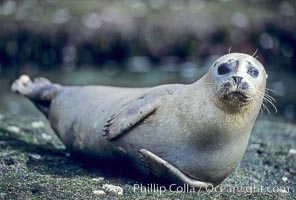
A Pacific harbor seal hauls out on a rock. This group of harbor seals, which has formed a breeding colony at a small but popular beach near San Diego, is at the center of considerable controversy. While harbor seals are protected from harassment by the Marine Mammal Protection Act and other legislation, local interests would like to see the seals leave so that people can resume using the beach.
Species: Pacific harbor seal, Phoca vitulina richardsi
Location: La Jolla, California
Image ID: 03010
Species: Pacific harbor seal, Phoca vitulina richardsi
Location: La Jolla, California
Image ID: 03010

A Pacific harbor seal hauls out on a rock. This group of harbor seals, which has formed a breeding colony at a small but popular beach near San Diego, is at the center of considerable controversy. While harbor seals are protected from harassment by the Marine Mammal Protection Act and other legislation, local interests would like to see the seals leave so that people can resume using the beach.
Species: Pacific harbor seal, Phoca vitulina richardsi
Location: La Jolla, California
Image ID: 03011
Species: Pacific harbor seal, Phoca vitulina richardsi
Location: La Jolla, California
Image ID: 03011
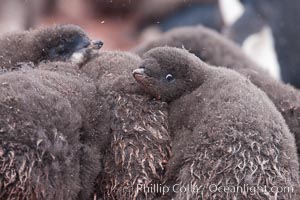
Adelie penguin chicks, huddle together in a snowstorm for warmth and protection. This group of chicks is known as a creche.
Species: Adelie penguin, Pygoscelis adeliae
Location: Shingle Cove, Coronation Island, South Orkney Islands, Southern Ocean
Image ID: 25026
Species: Adelie penguin, Pygoscelis adeliae
Location: Shingle Cove, Coronation Island, South Orkney Islands, Southern Ocean
Image ID: 25026

Adelie penguin chicks, huddle together in a snowstorm for warmth and protection. This group of chicks is known as a creche.
Species: Adelie penguin, Pygoscelis adeliae
Location: Shingle Cove, Coronation Island, South Orkney Islands, Southern Ocean
Image ID: 25168
Species: Adelie penguin, Pygoscelis adeliae
Location: Shingle Cove, Coronation Island, South Orkney Islands, Southern Ocean
Image ID: 25168

Pacific harbor seal swims in the protected waters of Childrens Pool in La Jolla, California. This group of harbor seals, which has formed a breeding colony at a small but popular beach near San Diego, is at the center of considerable controversy. While harbor seals are protected from harassment by the Marine Mammal Protection Act and other legislation, local interests would like to see the seals leave so that people can resume using the beach.
Species: Pacific harbor seal, Phoca vitulina richardsi
Location: La Jolla, California
Image ID: 03016
Species: Pacific harbor seal, Phoca vitulina richardsi
Location: La Jolla, California
Image ID: 03016